
How to Get Rid of Gnats in Houseplants (Fast, Safe & Natural Solutions)

You know you must get rid of gnats in houseplants when you see a few seemingly harmless specks dancing above the soil. Then suddenly, there are dozens of tiny black flying bugs in the soil. Every time you water, the gnats drift up from your pots like dust motes. Welcome to the most annoying pest of all: fungus gnats.
Adult fungus gnats love moisture-rich soil, laying eggs deep where light can’t reach. Those eggs hatch into fungus gnat larvae that feast on organic matter and sometimes your plant roots. You’ll see yellowing leaves, slower growth, and maybe even root rot if the gnat infestation keeps spreading. (Source: Colorado State University College of Agricultural Sciences.
Here’s the good part—this is fixable without harsh chemicals. Natural solutions really work: think BTi mosquito bits, yellow sticky traps, and a gentle hydrogen peroxide solution that targets larvae fast.
I’ve dealt with these pests in everything from Sansevieria zeylanica to Chinese Evergreens, and trust me, once you understand their life cycle, you can stop them for good.
A Reddit user once wrote, “They were in every single one of my plants—I almost gave up.” Don’t. There’s an easier way.
What Are Fungus Gnats on Plants?
Fungus gnats are tiny black flying insects measuring 0.06″ to 0.12″ (1.5 to 3 mm). They live in the moist soil of houseplants, thriving on organic matter. They have narrow legs, large heads, segmented antennae, and two light gray or transparent wings.
Gnats in plants are harmless to humans and pets. They do not bite. However, the gnat larvae can feed on plant roots. A large infestation can cause wilting leaves and potentially cause root rot. The gnats get into homes when introduced via new plants or contaminated soil from the garden.
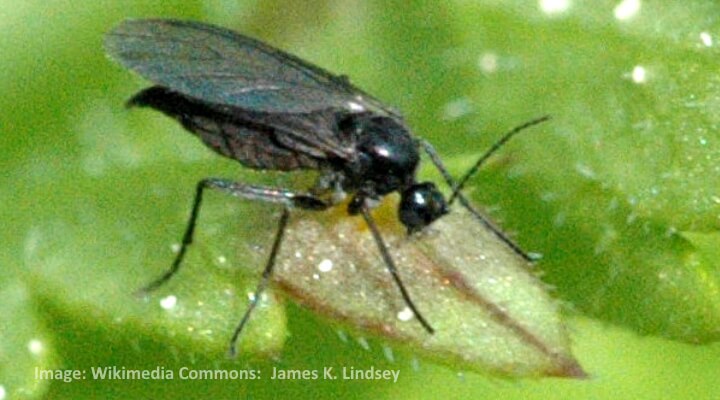
Below is a quick reference table for identifying fungus gnats:
| Feature | Description |
| Size | 0.06 to 0.12 inches (1.5 to 3 mm) |
| Color | Black |
| Legs | Narrow |
| Wings | Light gray or clear |
| Antennae | Segmented, larger than their head |
| Harm to humans or pets | None, as they do not bite |
| Harm to Plants | Larvae feed on plant roots and can cause wilting, stunted growth, or yellowing leaves |
To maintain the health of indoor plants, it is crucial to monitor and manage fungus gnat populations. For information on other plant pests, see our houseplant pest identification guide.
How to Get Rid of Gnats in Plants — Overview
Where Do Fungus Gnats on Plants Come From?
Gnats don’t appear out of nowhere. Most infestations start when you bring home new plants, reuse old potting mix, or plants are suffering in waterlogged soil.
The adults fly in through open windows, shipping boxes, or even hitch a ride from garden centres where fungus gnat eggs already exist in the compost.
They’re drawn to decomposing organic matter—bits of bark, old leaves, or fertiliser build-up in damp containers. Poor soil drainage and root rot turn your pot into the perfect nursery.
Pro tip: Always quarantine new house plants for a week and inspect the soil before placing them near others.
Reddit cue: “Mine came from a bag of compost I’d left open in the garage. They spread to every pot in a week.”
How to Identify Gnat Eggs in Houseplants
Gnat eggs are tiny, translucent ovals—about the size of a grain of sand. They’re usually clustered in the top inch of damp soil, especially near the base of stems or under fallen leaves.
You might never see them until they hatch, but a test using potato slices helps the most:
- Slice a raw potato.
- Lay it flat on the soil overnight.
- Check in the morning for larvae or eggs clinging underneath.
A magnifying glass or phone macro lens makes spotting them easier. If you find them, remove the top layer of potting mix, replace with dry compost, and start a soil drench with biological larvicide.
How to Identify Gnat Eggs
Identifyng gnat eggs in soil is challenging. Gnat eggs look like tiny, translucent balls, and often laid in moist organic matter. To identify them, inspect damp areas, such as soil or decaying plant material, for clusters of tiny, oval eggs. Use a magnifying glass if needed, as they’re barely visible to the naked eye, resembling miniature, gel-like spheres.
Fungus Gnat Life Cycle in Houseplants: Why They Keep Coming Back
Ever wondered why those gnats keep reappearing even after you’ve treated them? It’s not your imagination—they’re cycling through hidden stages in the soil, waiting for the perfect moment to resurface. Once you know how that cycle works, you can finally break it for good.
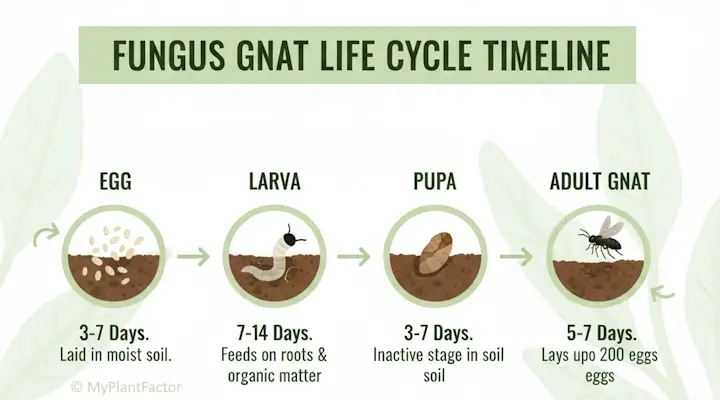
Stage 1 — Eggs in damp soil (3–6 days)
It starts small—literally. Each female lays hundreds of fungus gnat eggs in damp potting soil, tucked just beneath the surface. Warmth and high soil moisture make them hatch fast. Let that top layer dry out, and you’ll already stop half the next generation.
Stage 2 — Larvae feeding on fungi and roots (10–14 days)
Here’s where the real damage happens. The fungus gnat larvae squirm through soil, chewing on organic matter and sometimes your plant roots. You’ll notice yellowing leaves, mushy roots, and slower growth. Treat this stage with BTi bacteria or a mild hydrogen peroxide drench—both safe, effective fixes.
Stage 3 — Pupae near the surface (3–7 days)
Once they’re done feeding, larvae curl up just below the surface. It’s their rest phase before emerging as adults. A thin layer of gravel mulch or diatomaceous earth helps disrupt this stage—think of it as sealing the lid before they can escape.
Stage 4 — Adult gnats (live 7–10 days)
Adults live for only about a week, but in that time, each one can lay hundreds of eggs. That’s why sticky gnat traps work—they stop the next wave before it starts. Neem oil sprays help too, but drying the soil still matters most.
“I ignored the adults thinking they’d die off. Two weeks later, every pot was buzzing again,” a gardener commented online.
How long until fungus gnats are gone?
Expect progress within a week, but full recovery takes patience—at least two to three weeks. Fungus gnat eggs and larvae develop out of sight, so even when adults disappear, new ones can emerge for up to three weeks. Keep an eye on the soil—quiet doesn’t always mean they’re gone yet.
How to Identify a Fungus Gnat Infestation in Houseplants
If your indoor plants have been drooping or you see swarms of tiny black flies around indoor plants, you’re probably dealing with fungus gnats. These small, mosquito-like pests often go unnoticed until populations grow. (Source: Penn State Extension).
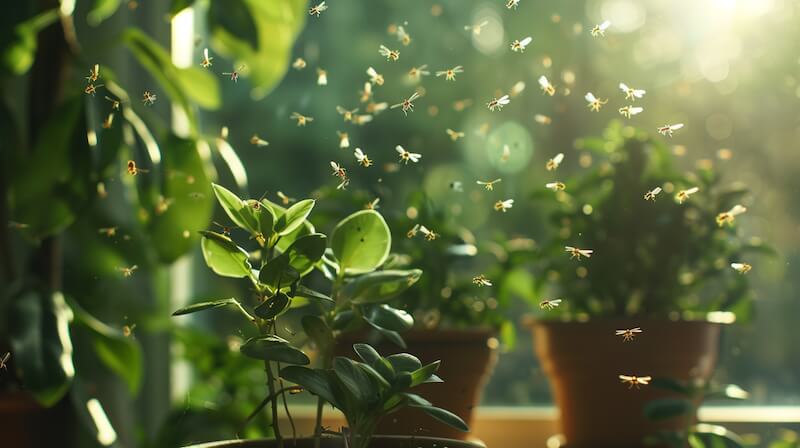
Common Signs in Soil and Leaves
You’ll notice the signs long before you spot the bugs. Leaves start yellowing, growth slows, and the soil stays damp even after days without watering. Tap the pot—and tiny black gnats drift up. That’s your clue.
Under the surface, fungus gnat larvae are chewing through organic matter and soft plant roots. It’s why leaves wilt, and roots feel mushy. Some people describe a faint, earthy smell—the scent of decay setting in.
“I thought my soil smelled like mushrooms. Turns out it was larvae,” someone wrote on Reddit’s r/houseplants.
Fungus Gnats vs. Fruit Flies or Drain Flies
Here’s how to tell the indoor plant pests apart. Fungus gnats are thin, with long legs and a black head, drawn to damp soil. Fruit flies buzz around fruit, while drain flies live near pipes. If they hover over your pots, they’re fungus gnats.
Still unsure? Try the potato detection method. Lay a thin slice on the soil overnight—if you find tiny white larvae clinging to the bottom, you’ve got them. Add a few yellow sticky traps nearby, and you’ll see just how busy your soil’s been.
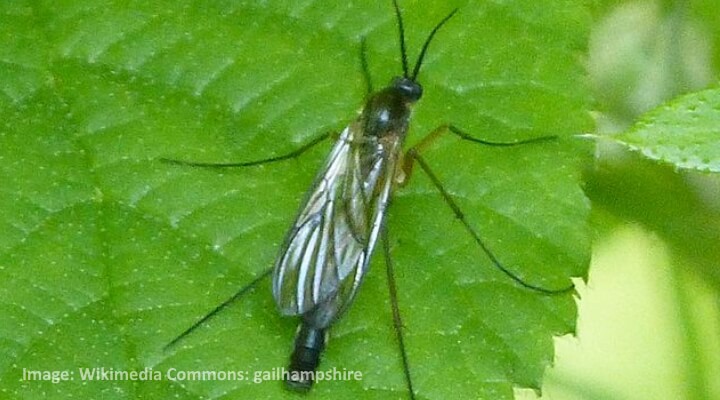
Can’t tell the difference between gnats and spider mites? Here’s my ultimate guide on how to identify spider mites on indoor plants. Fungus gnats can also look like thrips on plants.
3-Step Natural Control Method That Actually Works
Step 1 — Dry Out the Soil and Adjust Your Watering Schedule
Start simple—dry soil is your best weapon. Let that top layer crisp up before reaching for the watering can. No soggy saucers, no swampy compost. If the surface feels cool or dark, it’s still too wet. Keep it dry and watch the gnats panic.
Step 2 — Kill Fungus Gnat Larvae with Biological Controls
That’s where the real damage happens. Mix BTi bacteria into water and pour it through the soil—it kills larvae but leaves roots safe. A mild hydrogen peroxide solution works too, fizzing through the soil and clearing what you can’t see. For stubborn cases, try beneficial nematodes (Steinernema feltiae) because they’re natural larval predators.
Are you sure that you really have fungus gnats on plants? Why not check out our top guide to identifying tiny black bugs on houseplants.
Step 3 — Trap Adult Gnats Before They Reproduce
Those little flyers? They’re short-lived but relentless. Hang yellow sticky traps just above the soil or use a bowl of apple cider vinegar to lure them in. A light Neem oil spray keeps the rest from landing. Replace traps weekly until the buzzing stops for good.
Gnat Control Timeline
- Day 1–3: Dry the top inch of soil and start a BTi mosquito bits or hydrogen peroxide drench.
- Day 4–7: Replace yellow sticky traps and monitor for new adults.
- Day 8–10: Repeat soil treatment if gnats persist or larvae remain active.
- Day 11–14: Swap traps again—by now, adult populations should start declining.
- Day 15–21: Keep surface soil dry to prevent any remaining eggs from hatching.
Most infestations clear within three weeks when every stage—egg, larva, and adult—is interrupted.
Why Natural Homemade Methods Kill Fungus Gnats Effectively
Forget harsh sprays, the natural solutions in my “3-step control method” work because they hit fungus gnats where it hurts.
- Hydrogen peroxide fizzes through the soil.
- Neem oil scrambles their life cycle
- Sticky traps break their rhythm.
Each home remedy plays its part, turning simple pantry staples into a powerful, plant-safe defense system. Here’s how.
Hydrogen Peroxide: Why It Works for Fungus Gnat Control
Hydrogen peroxide releases oxygen when it hits moist soil—this oxygenation kills soft-bodied fungus gnat larvae instantly without harming roots. It also helps break down decaying organic matter that larvae feed on. Just don’t overuse—it can dry out roots if applied too often.
Apple Cider Vinegar: Trapping Adult Fungus Gnats Naturally
The sweet vinegar mimics the scent of fermenting organic matter, tricking adults into diving into the trap. It’s great for reducing visible numbers but won’t touch larvae, so it works best alongside BTi mosquito bits or soil-drying methods.
Diatomaceous Earth: A Physical Barrier That Stops Gnats
Diatomaceous earth (DE) doesn’t poison gnats—it dehydrates them. The fine powder damages their waxy coating, causing them to dry out. A light layer on top of dry soil prevents egg-laying and keeps pupae from emerging. Use food-grade DE and reapply after watering.
Neem Oil: Gentle Deterrent and Soil Protector
Neem oil acts as a growth regulator for pests, disrupting egg-laying and larval development. It also helps control fungal growth, making your soil less attractive to fungus gnat eggs. Mix 1 teaspoon of Neem oil with warm water and a drop of soap for a natural spray.
Neem oil is safe for plants and doesn’t harm pets. Discover more about this natural insecticide in our Ultimate Guide to Using Neem Oil Safely Indoors.
Sticky Traps: How They Break the Reproduction Cycle
Yellow sticky traps attract adults using color and scent. Trapping them interrupts egg-laying, effectively capping the next generation. Position traps close to soil level for the best results, and replace weekly until no new adults appear.
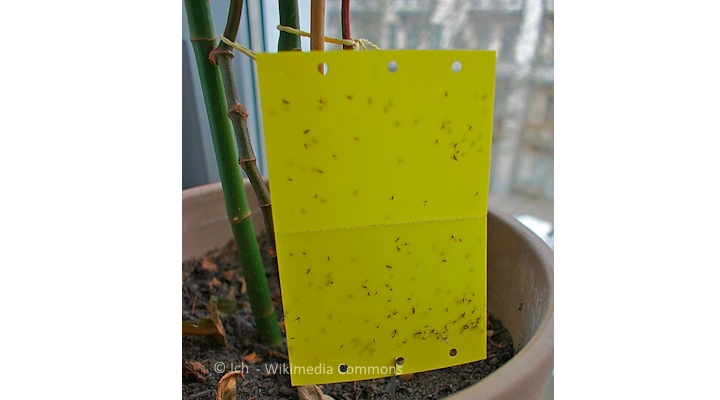
What Not to Do When Treating Fungus Gnats
It’s easy to panic when tiny flies take over your plants—but some “quick fixes” just feed the problem. A few common mistakes can turn a small fungus gnat issue into a full-blown invasion. Here’s what not to do, and when to call in backup.
Common Mistakes That Make It Worse
It’s tempting to go nuclear—but some fixes backfire. Overwatering just gives gnats more damp soil to breed in. And those vinegar traps? They only catch adults, not the hundreds of larvae still chewing below.
Repotting too soon spreads eggs everywhere. Spraying random insecticides doesn’t help either—they harm your plants and miss the soil-dwelling stages completely. The goal isn’t to kill fast; it’s to break their rhythm.
“I poured bleach in one pot,” someone admitted online. “Killed the plant. Gnats lived on.”
When to Call Professional Pest Control
If you’ve treated, dried, drenched, and trapped—and they keep coming back—it’s time to get backup. Professional pest control services use integrated pest management, safe for both indoor plants and pets.
They’ll check your potting soil, drainage, and even nearby compost bins for hidden sources. Think of it as a reset for your entire plant corner—a clean slate so the gnats don’t find a way back.
However, in my experience, it’s always possible to get rid of fungus gnats naturally with perseverence and patience.
How to Prevent Gnats in Houseplants
Once they’re gone, you’ll want to keep it that way. The secret? Make your soil less inviting. Fungus gnats love damp, still places—so tweak a few habits, and you’ll never see them again.
Quick Prevention Checklist
- ✅ Let the top inch of soil dry before watering again.
- ✅ Empty saucers so roots never sit in stagnant water.
- ✅ Use clean pots and fresh, well-draining potting mix.
- ✅ Add a thin gravel or sand layer to block egg-laying.
- ✅ Bottom-water plants so the surface stays dry.
- ✅ Keep air moving—fans and open windows help.
- ✅ Check new plants for gnat larvae before adding them to your space.
- ✅ Sprinkle BTi mosquito bits monthly as a preventive boost.
- ✅ Remove fallen leaves—gnats love decaying matter.
Stay consistent with these habits, and fungus gnats won’t stand a chance in your indoor garden.
- Let the top inch of soil dry before watering.
- Never leave saucers soggy or soil constantly moist.
- Use clean pots and fresh, well-draining potting mix.
- Add a thin gravel or sand layer to block egg-laying.
- Bottom water so the top stays dry.
- Keep air moving—fans and open windows help.
- Skip that half-used bag of compost; it may hide gnat eggs.
- Quarantine new houseplants for a week before placing them nearby.
- Drop in BTi mosquito bits every month as prevention.
- Brush away dead leaves—gnats love decaying matter.
Fungus Gnats in Houseplants: FAQs
Do fungus gnats ever go away on their own?
Rarely. If soil stays damp and rich in organic matter, new generations keep hatching. You must interrupt the life cycle so fresh eggs don’t replace the adults you’ve trapped.
Are fungus gnats harmful to humans or pets?
No. They don’t bite or sting. Heavy infestations stress plants and may encourage mold. Natural controls like BTi or neem are considered low-risk when used as directed.
Why do fungus gnats come back after treatment?
Eggs or larvae survived in damp pockets of soil. Even when adults vanish, new ones can emerge for two to three weeks. Keep the top layer dry long enough to outlast the cycle.
Can repotting get rid of fungus gnats?
Yes—if you remove all infested soil and use fresh, sterile potting mix. Any leftover media can reintroduce larvae. Pair repotting with a soil drench for best results.
Is hydrogen peroxide safe for indoor plants?
In moderation. A 1:4 hydrogen peroxide-to-water mix targets larvae on contact. Don’t overuse; repeated doses can dry roots and disrupt beneficial microbes.
What stops adult gnats fastest?
Yellow sticky traps at soil level reduce flyers within days. Small bowls of apple cider vinegar help monitor activity while soil treatments handle larvae below.
Can fungus gnats spread to other rooms or outdoors?
Yes. Adults can move to nearby pots or outdoor containers. Inspect neighboring plants and compost, and dry any persistently wet soil.
How do I know my plants are recovering?
New growth and firmer roots. Fewer or no new adults on traps for a week is another good sign. Continue prevention habits a little longer to lock it in.
